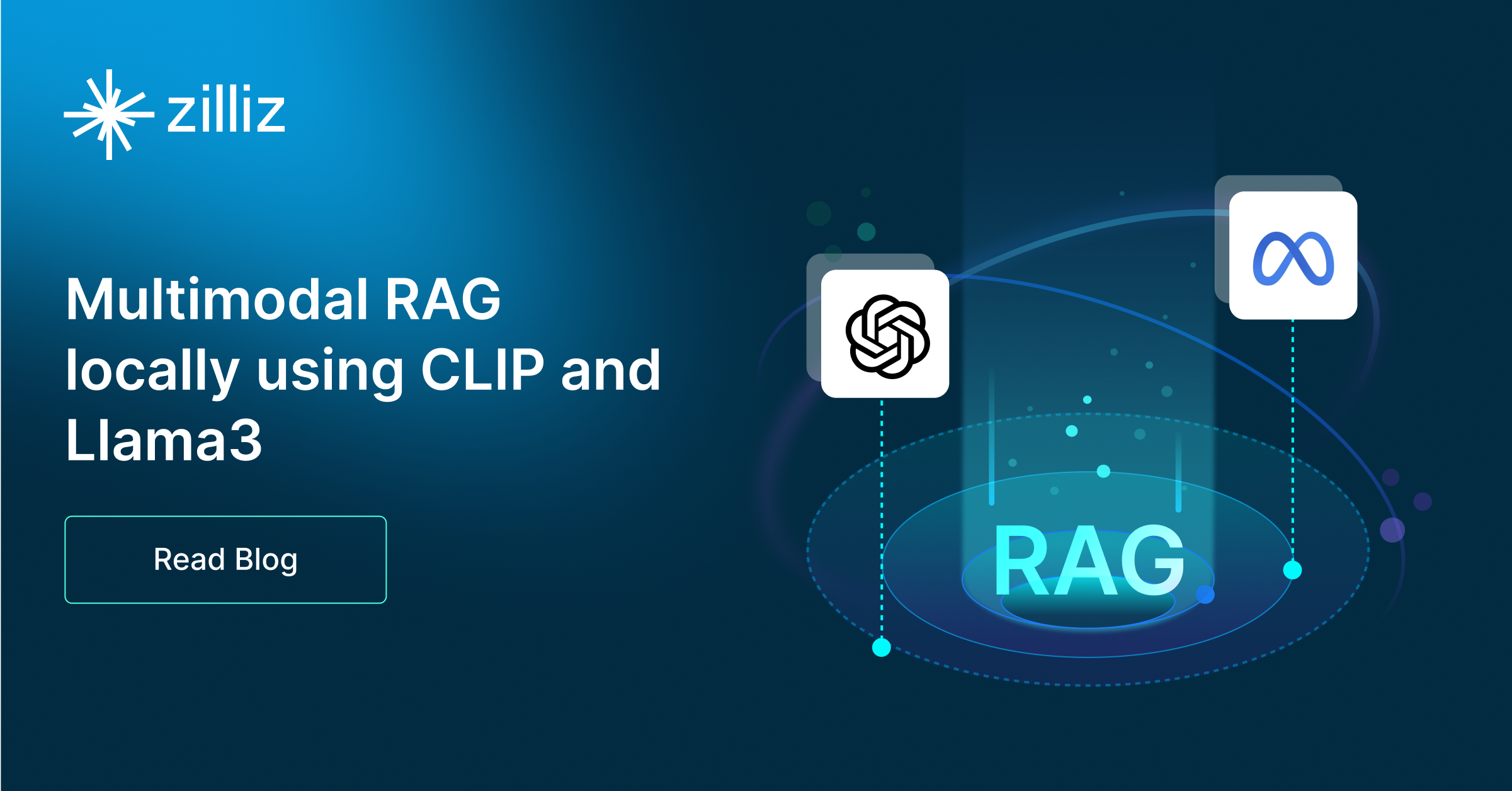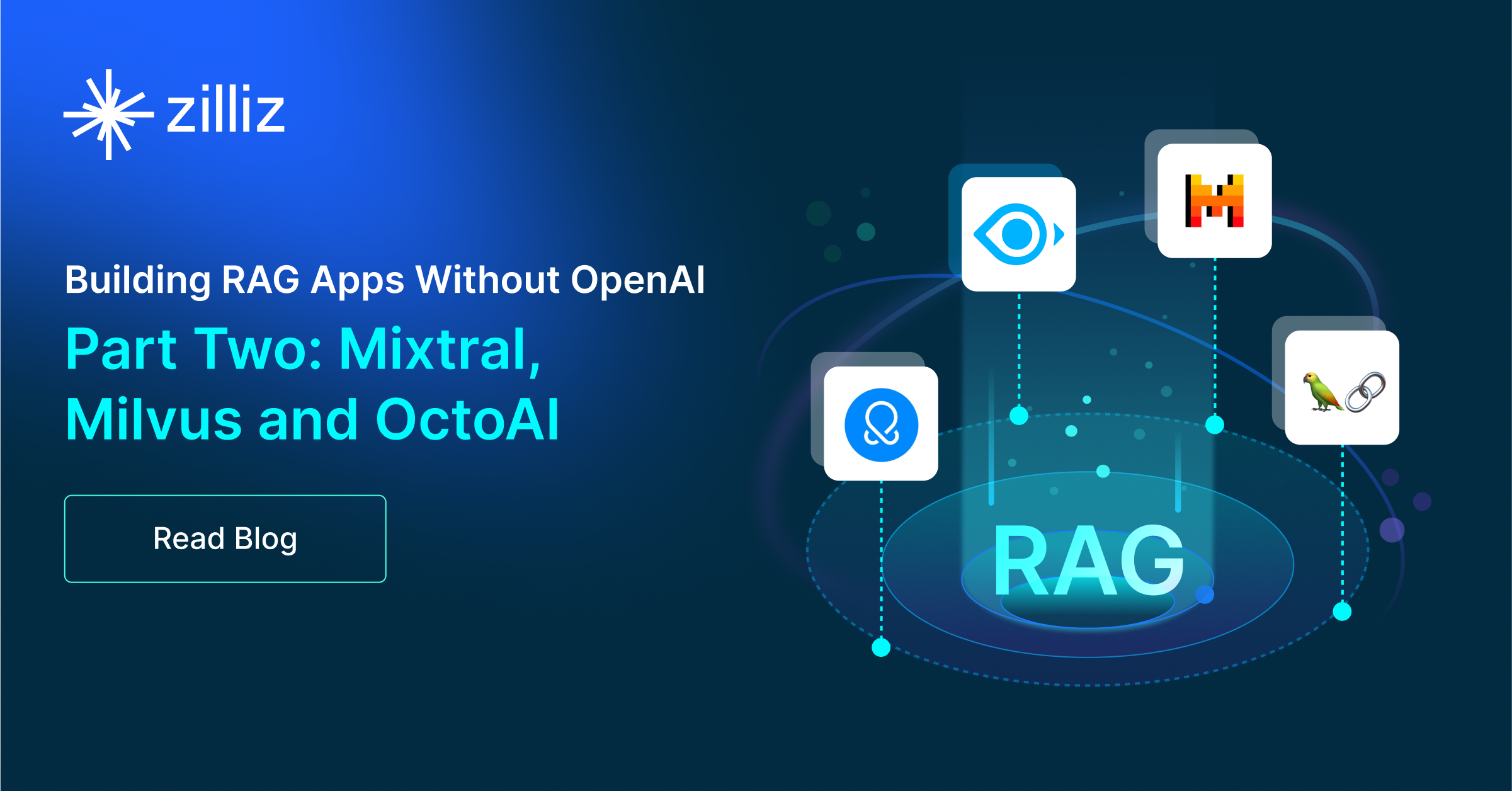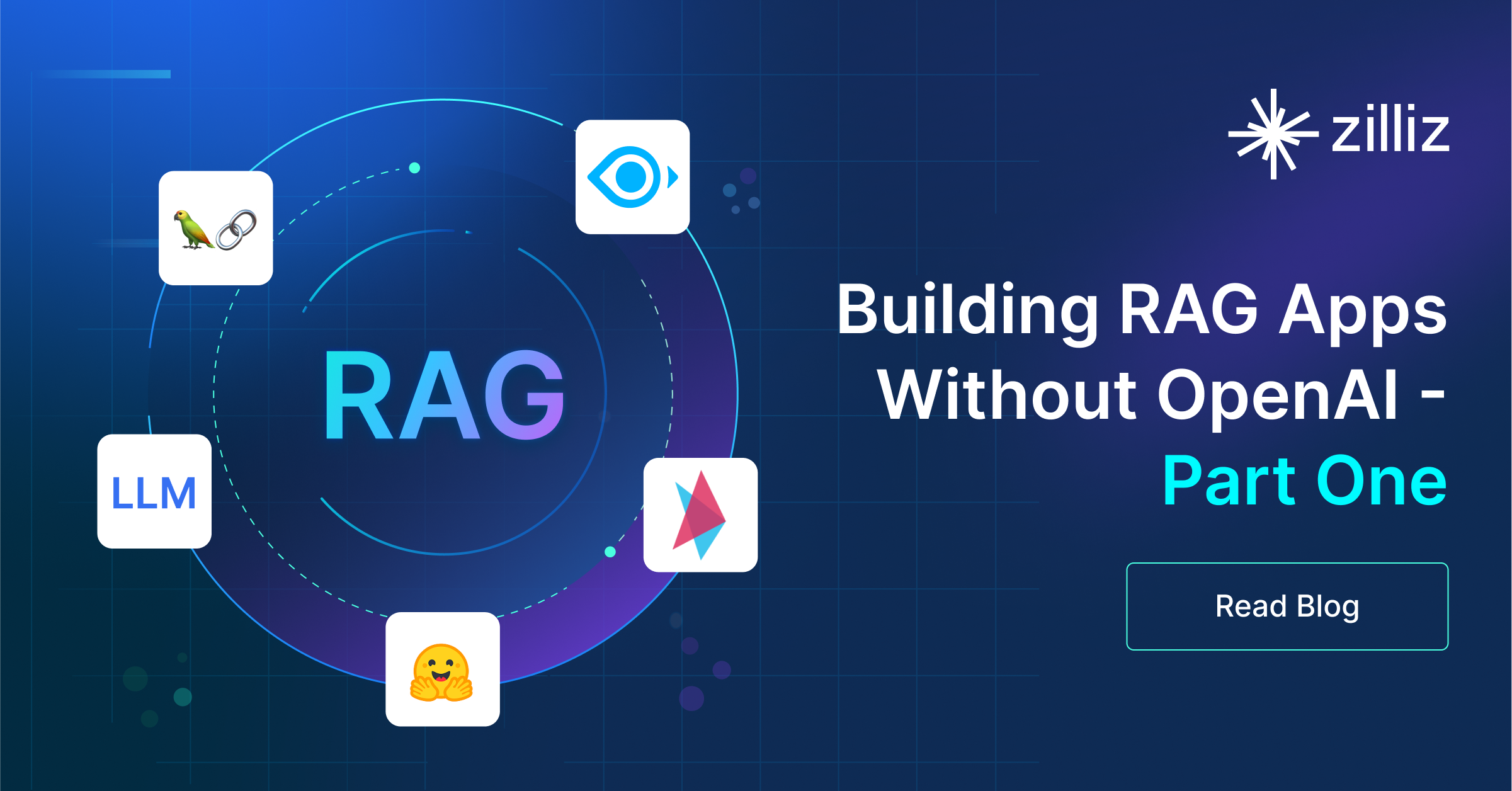Build RAG Chatbot with Haystack, Milvus, Amazon Bedrock Claude 3.5 Haiku, and jina-colbert-v2
Introduction to RAG
Retrieval-Augmented Generation (RAG) is a game-changer for GenAI applications, especially in conversational AI. It combines the power of pre-trained large language models (LLMs) like OpenAI’s GPT with external knowledge sources stored in vector databases such as Milvus and Zilliz Cloud, allowing for more accurate, contextually relevant, and up-to-date response generation. A RAG pipeline usually consists of four basic components: a vector database, an embedding model, an LLM, and a framework.
Key Components We'll Use for This RAG Chatbot
This tutorial shows you how to build a simple RAG chatbot in Python using the following components:
- Haystack: An open-source Python framework designed for building production-ready NLP applications, particularly question answering and semantic search systems. Haystack excels at retrieving information from large document collections through its modular architecture that combines retrieval and reader components. Ideal for developers creating search applications, chatbots, and knowledge management systems that require efficient document processing and accurate information extraction from unstructured text.
- Milvus: An open-source vector database optimized to store, index, and search large-scale vector embeddings efficiently, perfect for use cases like RAG, semantic search, and recommender systems. If you hate to manage your own infrastructure, we recommend using Zilliz Cloud, which is a fully managed vector database service built on Milvus and offers a free tier supporting up to 1 million vectors.
- AmazonBedrock Claude 3.5 Haiku: A high-efficiency AI model designed for fast, scalable processing of diverse tasks. Strengths include low-latency responses, cost-effectiveness, and seamless AWS integration. Ideal for real-time applications, high-volume data analysis, and enterprise solutions requiring reliable performance with minimal operational overhead.
- Jina-ColBERT-v2: A dense passage retrieval model optimized for semantic search and document ranking. It combines ColBERT's contextualized late interaction with efficient indexing, delivering high accuracy in understanding query intent and matching relevant text. Ideal for large-scale enterprise search, Q&A systems, and content discovery platforms requiring nuanced semantic understanding and rapid retrieval.
By the end of this tutorial, you’ll have a functional chatbot capable of answering questions based on a custom knowledge base.
Note: Since we may use proprietary models in our tutorials, make sure you have the required API key beforehand.
Step 1: Install and Set Up Haystack
import os
import requests
from haystack import Pipeline
from haystack.components.converters import MarkdownToDocument
from haystack.components.preprocessors import DocumentSplitter
from haystack.components.writers import DocumentWriter
Step 2: Install and Set Up Amazon Bedrock Claude 3.5 Haiku
Amazon Bedrock is a fully managed service that makes high-performing foundation models from leading AI startups and Amazon available through a unified API. You can choose from various foundation models to find the one best suited for your use case.
To use LLMs on Amazon Bedrock for text generation together with Haystack, you need to initialize an AmazonBedrockGenerator with the model name, the AWS credentials (AWS_ACCESS_KEY_ID, AWS_SECRET_ACCESS_KEY, AWS_DEFAULT_REGION) should be set as environment variables, be configured as described above or passed as Secret arguments. Note, make sure the region you set supports Amazon Bedrock.
Now, let's start installing and setting up models with Amazon Bedrock.
pip install amazon-bedrock-haystack
from haystack_integrations.components.generators.amazon_bedrock import AmazonBedrockGenerator
aws_access_key_id="..."
aws_secret_access_key="..."
aws_region_name="eu-central-1"
generator = AmazonBedrockGenerator(model="anthropic.claude-3-5-haiku-20241022-v1:0")
Step 3: Install and Set Up jina-colbert-v2
pip install jina-haystack
from haystack_integrations.components.embedders.jina import JinaTextEmbedder
from haystack_integrations.components.embedders.jina import JinaDocumentEmbedder
text_embedder = JinaTextEmbedder(api_key=Secret.from_token("<your-api-key>"), model="jina-colbert-v2")
document_embedder = JinaDocumentEmbedder(api_key=Secret.from_token("<your-api-key>"), model="jina-colbert-v2")
Step 4: Install and Set Up Milvus
pip install --upgrade pymilvus milvus-haystack
from milvus_haystack import MilvusDocumentStore
from milvus_haystack.milvus_embedding_retriever import MilvusEmbeddingRetriever
document_store = MilvusDocumentStore(connection_args={"uri": "./milvus.db"}, drop_old=True,)
retriever = MilvusEmbeddingRetriever(document_store=document_store, top_k=3)
Step 5: Build a RAG Chatbot
Now that you’ve set up all components, let’s start to build a simple chatbot. We’ll use the Milvus introduction doc as a private knowledge base. You can replace it your own dataset to customize your RAG chatbot.
url = 'https://raw.githubusercontent.com/milvus-io/milvus-docs/refs/heads/v2.5.x/site/en/about/overview.md'
example_file = 'example_file.md'
response = requests.get(url)
with open(example_file, 'wb') as f:
f.write(response.content)
file_paths = [example_file] # You can replace it with your own file paths.
indexing_pipeline = Pipeline()
indexing_pipeline.add_component("converter", MarkdownToDocument())
indexing_pipeline.add_component("splitter", DocumentSplitter(split_by="sentence", split_length=2))
indexing_pipeline.add_component("embedder", document_embedder)
indexing_pipeline.add_component("writer", DocumentWriter(document_store))
indexing_pipeline.connect("converter", "splitter")
indexing_pipeline.connect("splitter", "embedder")
indexing_pipeline.connect("embedder", "writer")
indexing_pipeline.run({"converter": {"sources": file_paths}})
# print("Number of documents:", document_store.count_documents())
question = "What is Milvus?" # You can replace it with your own question.
retrieval_pipeline = Pipeline()
retrieval_pipeline.add_component("embedder", text_embedder)
retrieval_pipeline.add_component("retriever", retriever)
retrieval_pipeline.connect("embedder", "retriever")
retrieval_results = retrieval_pipeline.run({"embedder": {"text": question}})
# for doc in retrieval_results["retriever"]["documents"]:
# print(doc.content)
# print("-" * 10)
from haystack.utils import Secret
from haystack.components.builders import PromptBuilder
retriever = MilvusEmbeddingRetriever(document_store=document_store, top_k=3)
text_embedder = JinaTextEmbedder(api_key=Secret.from_token("<your-api-key>"), model="jina-colbert-v2")
prompt_template = """Answer the following query based on the provided context. If the context does
not include an answer, reply with 'I don't know'.\n
Query: {{query}}
Documents:
{% for doc in documents %}
{{ doc.content }}
{% endfor %}
Answer:
"""
rag_pipeline = Pipeline()
rag_pipeline.add_component("text_embedder", text_embedder)
rag_pipeline.add_component("retriever", retriever)
rag_pipeline.add_component("prompt_builder", PromptBuilder(template=prompt_template))
rag_pipeline.add_component("generator", generator)
rag_pipeline.connect("text_embedder.embedding", "retriever.query_embedding")
rag_pipeline.connect("retriever.documents", "prompt_builder.documents")
rag_pipeline.connect("prompt_builder", "generator")
results = rag_pipeline.run({"text_embedder": {"text": question}, "prompt_builder": {"query": question},})
print('RAG answer:\n', results["generator"]["replies"][0])
Optimization Tips
As you build your RAG system, optimization is key to ensuring peak performance and efficiency. While setting up the components is an essential first step, fine-tuning each one will help you create a solution that works even better and scales seamlessly. In this section, we’ll share some practical tips for optimizing all these components, giving you the edge to build smarter, faster, and more responsive RAG applications.
Haystack optimization tips
To optimize Haystack in a RAG setup, ensure you use an efficient retriever like FAISS or Milvus for scalable and fast similarity searches. Fine-tune your document store settings, such as indexing strategies and storage backends, to balance speed and accuracy. Use batch processing for embedding generation to reduce latency and optimize API calls. Leverage Haystack's pipeline caching to avoid redundant computations, especially for frequently queried documents. Tune your reader model by selecting a lightweight yet accurate transformer-based model like DistilBERT to speed up response times. Implement query rewriting or filtering techniques to enhance retrieval quality, ensuring the most relevant documents are retrieved for generation. Finally, monitor system performance with Haystack’s built-in evaluation tools to iteratively refine your setup based on real-world query performance.
Milvus optimization tips
Milvus serves as a highly efficient vector database, critical for retrieval tasks in a RAG system. To optimize its performance, ensure that indexes are properly built to balance speed and accuracy; consider utilizing HNSW (Hierarchical Navigable Small World) for efficient nearest neighbor search where response time is crucial. Partitioning data based on usage patterns can enhance query performance and reduce load times, enabling better scalability. Regularly monitor and adjust cache settings based on query frequency to avoid latency during data retrieval. Employ batch processing for vector insertions, which can minimize database lock contention and enhance overall throughput. Additionally, fine-tune the model parameters by experimenting with the dimensionality of the vectors; higher dimensions can improve retrieval accuracy but may increase search time, necessitating a balance tailored to your specific use case and hardware infrastructure.
AmazonBedrock Claude 3.5 Haiku optimization tips
Optimize chunk size for retrieved context to balance relevance and processing efficiency, aiming for 500-800 tokens. Structure inputs with clear separators between user queries and retrieved documents, and use system prompts like "Base responses on the provided context" to reduce hallucinations. Fine-tune parameters: lower temperature (0.2-0.4) for factual accuracy, adjust max_tokens to trim verbose outputs, and enable caching for repeated queries. Preprocess retrieved data to remove noise, validate outputs against source relevance, and implement batch processing for cost-effective scaling. Monitor latency and error rates via Amazon CloudWatch to refine performance.
jina-colbert-v2 optimization tips
To optimize jina-colbert-v2 in a RAG setup, ensure input text is preprocessed by truncating or chunking documents to fit its 512-token limit, preserving context. Use batch inference for dense embeddings to maximize GPU utilization. Fine-tune on domain-specific data to improve relevance. Leverage ColBERT’s late interaction by precomputing document embeddings and caching them for faster retrieval. Adjust the compression ratio for query-document token tensors to balance speed and accuracy. Filter irrelevant documents early using metadata to reduce computational overhead. Monitor retrieval latency and accuracy to iteratively refine parameters.
By implementing these tips across your components, you'll be able to enhance the performance and functionality of your RAG system, ensuring it’s optimized for both speed and accuracy. Keep testing, iterating, and refining your setup to stay ahead in the ever-evolving world of AI development.
RAG Cost Calculator: A Free Tool to Calculate Your Cost in Seconds
Estimating the cost of a Retrieval-Augmented Generation (RAG) pipeline involves analyzing expenses across vector storage, compute resources, and API usage. Key cost drivers include vector database queries, embedding generation, and LLM inference.
RAG Cost Calculator is a free tool that quickly estimates the cost of building a RAG pipeline, including chunking, embedding, vector storage/search, and LLM generation. It also helps you identify cost-saving opportunities and achieve up to 10x cost reduction on vector databases with the serverless option.
 Calculate your RAG cost
Calculate your RAG cost
What Have You Learned?
By diving into this tutorial, you’ve unlocked the power of combining cutting-edge tools to build a robust RAG system from the ground up! You learned how Haystack serves as the flexible framework that stitches everything together, orchestrating workflows to process and retrieve information seamlessly. Milvus, your high-performance vector database, stepped in to handle lightning-fast similarity searches, ensuring your system can scale effortlessly even with massive datasets. Then, Amazon Bedrock’s Claude 3.5 Haiku brought its A-game as the LLM, generating human-like responses that feel natural and insightful, all while balancing speed and cost-efficiency. And let’s not forget jina-colbert-v2, the embedding model that transformed your raw data into rich, meaningful vectors, capturing nuances that make retrieval accurate and context-aware. Together, these tools formed a dynamic pipeline where each component plays a critical role—ingesting data, retrieving context, and synthesizing answers—proving that RAG isn’t just a buzzword but a practical, transformative solution.
But this tutorial didn’t stop there! You also picked up pro tips for optimizing your RAG system, like tweaking chunk sizes for better performance or using the included free RAG cost calculator to estimate expenses and fine-trade-offs. These insights ensure your projects aren’t just functional but also efficient and budget-friendly. Now that you’ve seen how these pieces fit together—and how they can evolve—it’s time to take the wheel. Experiment with different models, refine your retrieval strategies, or even build custom features tailored to your needs. The world of AI is moving fast, and you’re equipped to keep pace. So go ahead—build something bold, iterate fearlessly, and let your creativity shape the future of intelligent applications. The possibilities are endless, and you’re ready to chase them!
Further Resources
🌟 In addition to this RAG tutorial, unleash your full potential with these incredible resources to level up your RAG skills.
- How to Build a Multimodal RAG | Documentation
- How to Enhance the Performance of Your RAG Pipeline
- Graph RAG with Milvus | Documentation
- How to Evaluate RAG Applications - Zilliz Learn
- Generative AI Resource Hub | Zilliz
We'd Love to Hear What You Think!
We’d love to hear your thoughts! 🌟 Leave your questions or comments below or join our vibrant Milvus Discord community to share your experiences, ask questions, or connect with thousands of AI enthusiasts. Your journey matters to us!
If you like this tutorial, show your support by giving our Milvus GitHub repo a star ⭐—it means the world to us and inspires us to keep creating! 💖
- Introduction to RAG
- Key Components We'll Use for This RAG Chatbot
- Step 1: Install and Set Up Haystack
- Step 2: Install and Set Up Amazon Bedrock Claude 3.5 Haiku
- Step 3: Install and Set Up jina-colbert-v2
- Step 4: Install and Set Up Milvus
- Step 5: Build a RAG Chatbot
- Optimization Tips
- RAG Cost Calculator: A Free Tool to Calculate Your Cost in Seconds
- What Have You Learned?
- Further Resources
- We'd Love to Hear What You Think!
Content
Vector Database at Scale
Zilliz Cloud is a fully-managed vector database built for scale, perfect for your RAG apps.
Try Zilliz Cloud for Free


